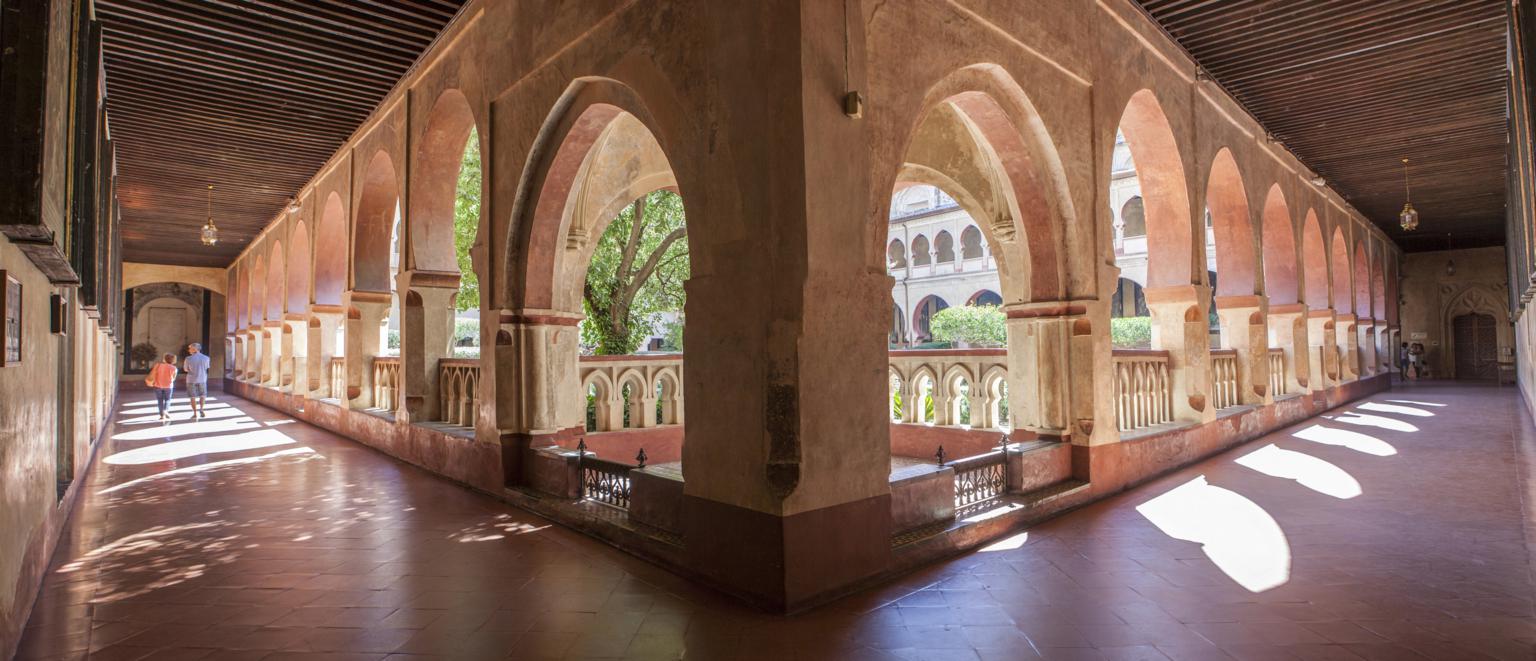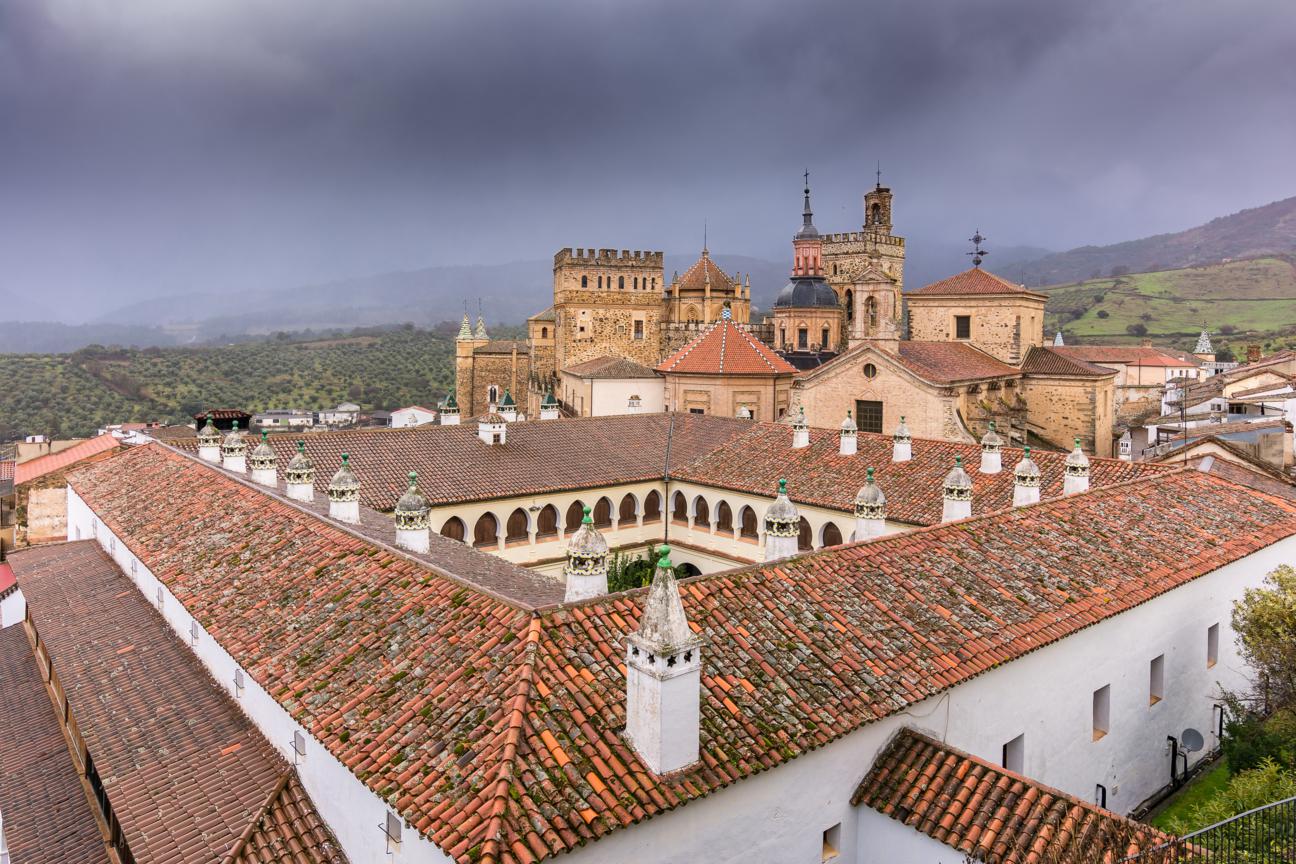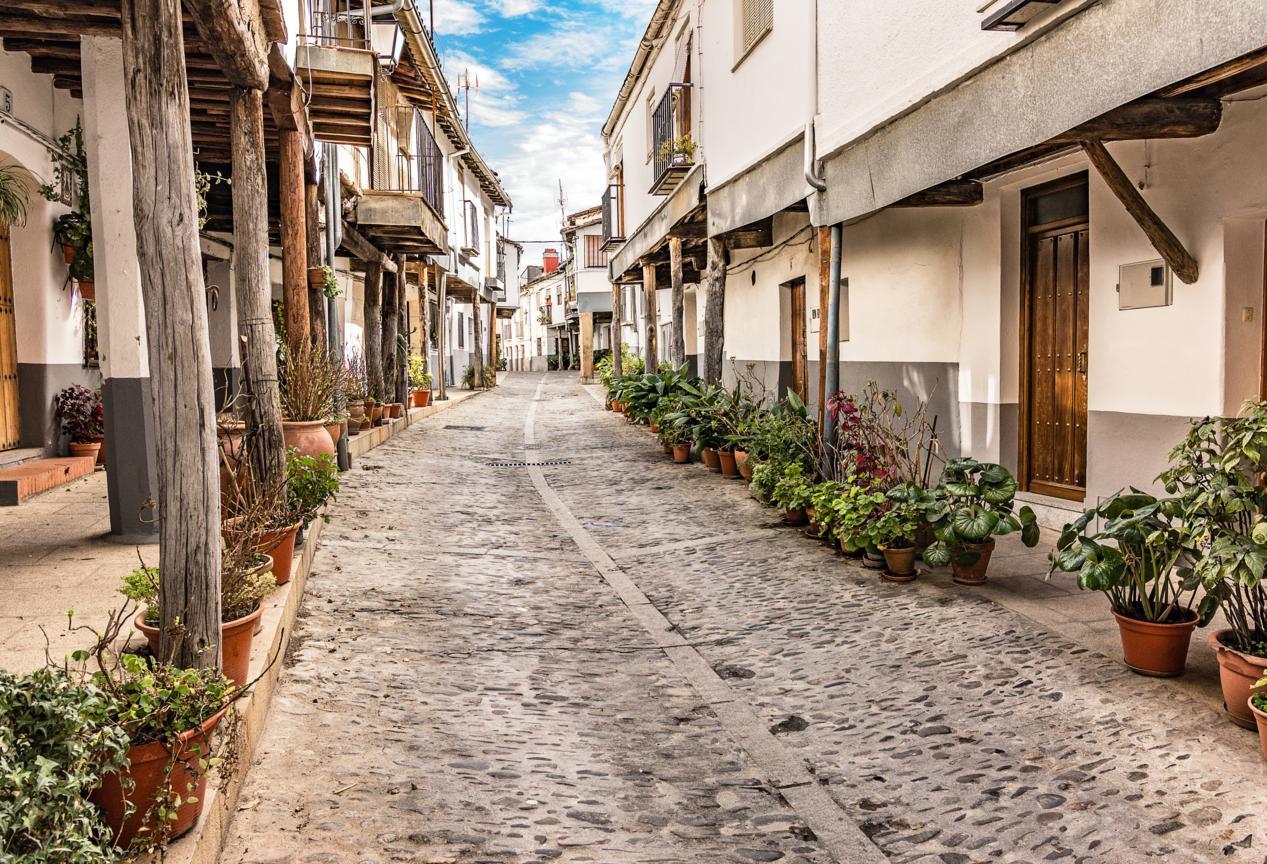Guadalupe, patrimonio espiritual / Guadalupe, spiritual heritage

Miles de peregrinos recorren los caminos que llevan a Guadalupe con motivo de la celebración del Año Santo Guadalupense. La tradición se conmemora desde 1536 y el Real Monasterio de Guadalupe recibe al caminante que llega a este enclave, considerado referencia espiritual de Extremadura que celebra su patrona cada 8 de septiembre. El Real Monasterio fue declarado Monumento Nacional en 1879 y posteriormente, en 1993, Patrimonio de la Humanidad por la UNESCO.
Es costumbre de los peregrinos atravesar la Puerta Santa de la Basílica y palpar las piedras que dan acceso a la nave de Santa Ana y que, según la tradición, cubrió la imagen de la Virgen tras haber sido sepultada por la invasión árabe en el año 714. La herencia cristiana dice que algunos peregrinos encontraron la sanación de sus enfermedades al tocar las piedras y su gracia está recogida en los códices de los milagros del Real Monasterio de Guadalupe, que nos recibe con una fachada principal mudéjar que da paso a dos claustros, uno de estilo gótico y otro mudéjar.

Guadalupe es un pueblo de una belleza singular, pero también un referente religioso que otorga la gracia del jubileo. El primer Año Jubilar fue establecido por el Papa Paulo III en 1536 y bajo el mandato de Juan Pablo II se concedieron los años jubilares. Para ganar el perdón de sus pecados el peregrino debe adentrarse en la majestuosa Basílica de Guadalupe donde, según una antigua leyenda, se apareció la Virgen María al pastor Gil Cordero a finales del siglo XIII; su Iglesia se considera desde 1340 el primer Santuario Nacional.
El Real Monasterio conserva libros miniados, bordados, relicarios y obras pictóricas de Zurbarán, El Greco y otros pintores, pero también esculturas, orfebrería y bronces. El templo es gótico del siglo XV y el coro y la sillería son obras de Manuel de Larra Churriguera, mientras que la imagen de la Virgen de Guadalupe data de los siglos XII-XIII. El peregrino debe subir al Camarín para encontrarse con la Virgen de Guadalupe, besar su reliquia y contemplar de cerca la dulzura de su moreno semblante, porque nos encontramos en un importante centro de devoción mariana al que han acudido personajes históricos como Cristóbal Colón, Hernán Cortés, Carlos V, Miguel de Cervantes o Santa Teresa de Jesús.

Los viejos caminos que conducen a esta villa espiritual, transitados hoy en día por centenares de peregrinos, representan la Red de Caminos de Guadalupe. Son bellas vías históricas de peregrinación que, como el Camino Real que parte desde la capital de España, regalan al caminante paisajes únicos que alientan el esfuerzo previo al Jubileo.
Guadalupe invita a pasear sin prisas por sus pintorescas plazas y callejuelas, a descubrir los paisajes del Geparque Mundial de la UNESCO Villuercas Ibores Jara y a degustar una cocina reconfortante que hará que el peregrino reponga fuerzas con una gastronomía de reconocida calidad internacional. La buena mesa de este municipio nos invita a probar su afamada morcilla -considerada una exquisitez como tapa o plato principal-, los quesos con Denominación de Origen Ibores, los productos de la dehesa, la miel con DOP Villuercas-Ibores, las migas, la caldereta de cordero o venado así como sus excelentes vinos y una exquisita repostería tradicional.

La Navidad se ha convertido en un atractivo muy especial desde 2017, año en el que una popular marca de bombones premió a Guadalupe con una espectacular iluminación que cada año atrae a miles de personas deseosas de ver las calles engalanadas con guirnaldas y luces multicolores que constituyen un elemento diferenciador que da a conocer sus recursos turísticos, su cultura y su gastronomía.
Thousands of pilgrims walk along the paths that lead to Guadalupe in order to celebrate the Guadalupe Holy Year in 2020. The tradition has been commemorated since 1536 and the Guadalupe Royal Monastery welcomes the walker who reaches this enclave, considered to be the spiritual reference point of Extremadura and which celebrates its patron every September 8th. The Royal Monastery was declared a national monument in 1879 and subsequently, in 1993, World Heritage by UNESCO.
It is a tradition for pilgrims to cross the 'Puerta Santa de la Basílica' (the holy doorway) and touch the stones that lead the way to the Santa Ana nave and that, according to tradition, covered up the image of the Virgin after having been sepultured there by the Arabic invasion of 714. Christian heritage has it that some pilgrims found the cure for their illnesses on touching the stones and their grace is registered in the codices of the miracles of the Guadalupe Royal Monastery, a building which greets us with a Mudejar main façade that leads into two cloisters, one Gothic in style, the other, Mudejar.
Guadalupe is a town of singular beauty, at the same time it is a religious centre that grants the grace of the jubilee. The first Jubilee Year was established by Pope Paulo III in 1536 and jubilee years were granted under the mandate of Juan Pablo II. To gain forgiveness for their sins, the pilgrim had to go into the majestic Guadalupe Basilica, where, according to an old legend, the Virgin Mary appeared before the shepherd, Gil Cordero towards the end of the thirteenth century. The church has been known as the first 'Santuario Nacional' (national shrine) since 1340.
The Royal Monastery preserves illuminated manuscripts, embroidery, relics and pictorial works by Zurbarán, El Greco and other painters; it also holds sculptures, gold and silverwork, and bronzes. The temple is Gothic, dating back to the fifteenth century, and the choir and pews are the work of Manuel de Larra Churriguera; furthermore, the image of the Virgin of Guadalupe can be dated to the twelfth and thirteenth centuries. The pilgrim should go up to the chapel called the 'Camarín' to meet the Virgin of Guadalupe, kiss her remains and contemplate up close the sweetness of her dark-skinned face, because we are in an important Marian devotional centre to which have come historic figures such as Cristóbal Colón, Hernán Cortés, Carlos V, Miguel de Cervantes or Santa Teresa de Jesús.
The ancient paths that lead to this spiritual village, nowadays transited by hundreds of pilgrims, make up the Red de Caminos de Guadalupe (the Guadalupe network of paths). They are gorgeous, historical pilgrimage routes which, like the 'Camino Real' (the Royal Way) that starts out at the Spanish capital, provide the walker with unique landscapes that inspire the effort needed prior to the Jubilee.
Guadalupe invites you to gently stroll along its picturesque squares and alleys, to discover the landscapes in the UNESCO Geparque Mundial, Villuercas-Ibores, Jara and savour hearty cuisine that will help the pilgrim recover his strength with gastronomy of renowned international quality. This town's fine food demands we try out the famous black pudding, known locally as 'morcilla' – considered a delicacy as a starter or snack or as a main course, the cheeses of the Ibores 'Denominación de Origen' seal, the products derived from the meadows, the 'DOP' Villuercas-Ibores stamped honey, the 'migas' (a dish made from fried breadcrumbs), the lamb or venison stew, all alongside its excellent wines and an exquisite, traditional dessert selection.
Christmas has become a very special event since 2017, the year when a popular brand of confectionery awarded Guadalupe a splendid lights show which each year attracts thousands of people who are keen to see the streets decked with garlands and multi-coloured lights, which make up a distinguishing factor by which to get to know a place's touristic offering, its culture and its cuisine.







